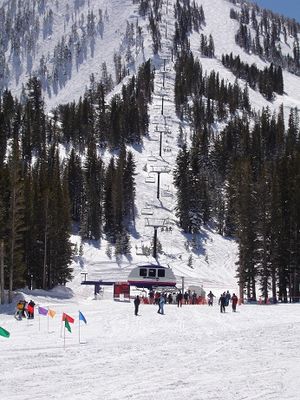Ski lift facts for kids
Ski lifts are special machines that help people travel up and down mountains, especially at ski resorts. They make it much easier to get to the top of a ski slope without having to walk. There are different kinds of ski lifts, like chairs that hang from a cable or enclosed cabins that carry many people. They are a super important part of skiing and snowboarding, allowing everyone to enjoy the slopes more easily.
Contents
What is a Ski Lift?
A ski lift is a type of transport system that moves people up a mountain. It uses strong cables and towers to carry skiers and snowboarders. Imagine a giant conveyor belt for people, but going up a steep hill! These lifts are designed to work safely in all kinds of weather, from sunny days to snowy storms. They help people save energy so they can spend more time enjoying their favorite winter sports.
How Do Ski Lifts Work?
Most ski lifts work using a long, strong steel cable that forms a continuous loop. This cable is supported by tall towers, called "pylons," that are placed along the mountain. A powerful engine, usually at the bottom or top of the lift, pulls the cable around. Attached to this moving cable are the chairs, gondolas, or other carriers that people ride in. When you get on, the carrier moves you smoothly up the mountain. When you reach the top, you simply get off, and the carrier continues its journey.
Types of Ski Lifts
There are several different types of ski lifts, each designed for different needs and terrains. Some are open to the air, while others are enclosed and warm.
Chairlifts
Chairlifts are the most common type of ski lift. They have chairs that hang from a moving cable. Each chair can usually carry two, four, six, or even eight people. When you get on a chairlift, you sit down, and a safety bar often comes down to keep you secure. They are popular because they are easy to use and offer great views of the mountain.
- Fixed-grip chairlifts: These chairs are permanently attached to the cable. They move at a constant speed, which means they can be a bit tricky to get on and off if you're not used to them.
- Detachable chairlifts: These are more modern. The chairs detach from the main cable at the loading and unloading areas. This allows them to slow down a lot, making it much easier and safer to get on and off. Once you're on, the chair re-attaches to the fast-moving cable for the ride up the mountain.
Gondolas and Cable Cars
Gondolas and cable cars are enclosed cabins that carry people up the mountain. They are great for keeping warm and dry, especially on cold or snowy days.
- Gondolas: These are usually smaller cabins that can hold 4 to 10 people. They are often detachable, slowing down for easy boarding. You take off your skis or snowboard before getting in.
- Aerial tramways (Cable Cars): These are much larger cabins that can hold many people, sometimes over 100! They usually run on two fixed cables, with a third cable pulling the cabin. They often travel long distances and climb very steep slopes, offering amazing panoramic views.
Surface Lifts
Surface lifts are different because they pull skiers and snowboarders along the ground, rather than lifting them high into the air. They are often found on gentler slopes or in beginner areas.
- T-bars and J-bars: These lifts have a bar that you place behind you, or between your legs, and it pulls you up the slope while your skis or snowboard stay on the ground.
- Rope tows: These are simple ropes that you hold onto, or a handle attached to a rope, that pulls you up.
- Magic carpets: These are like moving conveyor belts on the snow. They are very easy to use and are perfect for young children or beginners learning to ski.
Funiculars
While not always considered a "ski lift" in the traditional sense, funiculars are railway systems that use cables to pull carriages up steep slopes. They are sometimes used in ski resorts to transport large numbers of people, often through tunnels or up very steep sections of the mountain where other lifts might not be practical.
History of Ski Lifts
The idea of using machines to help people up mountains for skiing started a long time ago. One of the very first ski lifts was built in 1908 in Germany. It was a simple rope tow. The first chairlift was built in 1936 at Sun Valley Resort in Idaho, United States. It was inspired by a system used to load bananas onto ships! Since then, ski lifts have become much more advanced, safer, and faster, making skiing and snowboarding accessible to millions of people around the world.
Safety on Ski Lifts
Ski lifts are very safe, but it's important to follow some simple rules to make sure everyone has a good time and stays safe:
- Always listen to the lift operators. They are there to help you.
- Make sure your clothing and equipment are not tangled before you get on.
- When getting on a chairlift, look over your shoulder and grab the chair as it comes around.
- Once on, lower the safety bar if there is one.
- Do not swing or bounce on the lift.
- When getting off, make sure your skis or snowboard are pointed downhill and stand up smoothly.
- Move away from the unloading area quickly so others can get off safely.
Images for kids
See also
 In Spanish: Remonte (esquí) para niños
In Spanish: Remonte (esquí) para niños





